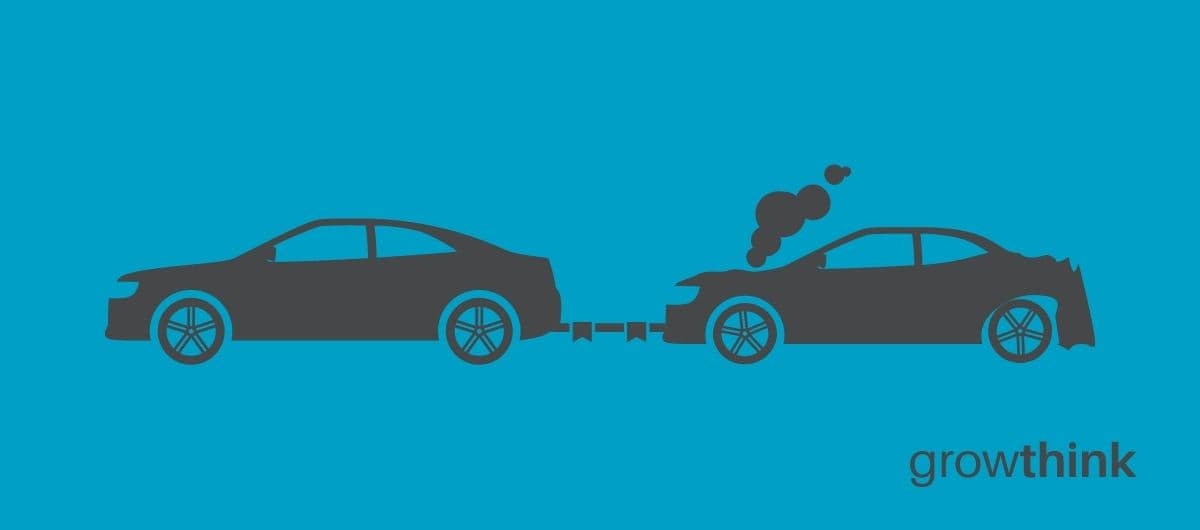Starting a hauling business can be very profitable. With proper planning, execution and hard work, you can enjoy great success. Below you will learn the keys to launching a successful hauling business.
Importantly, a critical step in starting a hauling business is to complete your business plan. To help you out, you should download Growthink’s Ultimate Business Plan Template here.
14 Steps To Start a Hauling Business:
- Choose the Name for Your Hauling Business
- Develop Your Hauling Business Plan
- Choose the Legal Structure for Your Hauling Business
- Secure Startup Funding for Your Hauling Business (If Needed)
- Secure a Location for Your Business
- Register Your Hauling Business with the IRS
- Open a Business Bank Account
- Get a Business Credit Card
- Get the Required Business Licenses and Permits
- Get Business Insurance for Your Hauling Business
- Buy or Lease the Right Hauling Business Equipment
- Develop Your Hauling Business Marketing Materials
- Purchase and Setup the Software Needed to Run Your Hauling Business
- Open for Business
1. Choose the Name for Your Hauling Business
The first step to starting a hauling business is to choose your business’ name.
This is a very important choice since your company name is your brand and will last for the lifetime of your business. Ideally you choose a name that is meaningful and memorable. Here are some tips for choosing a name for your hauling business:
- Make sure the name is available. Check your desired name against trademark databases and your state’s list of registered business names to see if it’s available. Also check to see if a suitable domain name is available.
- Keep it simple. The best names are usually ones that are easy to remember, pronounce and spell.
- Think about marketing. Come up with a name that reflects the desired brand and/or focus of your hauling business.
2. Develop Your Hauling Business Plan
One of the most important steps in starting a hauling business is to develop your business plan. The process of creating your plan ensures that you fully understand your market and your business strategy. The plan also provides you with a roadmap to follow and if needed, to present to funding sources to raise capital for your business.
Your business plan should include the following sections:
- Executive Summary – this section should summarize your entire business plan so readers can quickly understand the key details of your own trucking company.
- Company Overview – this section tells the reader about the history of your hauling business and what type of hauling business you operate. For example, are you a trucking company, freight forwarder, or a courier service?
- Industry Analysis – here you will document key information about the trucking industry. Conduct market research and document how big the industry is and what trends are affecting it.
- Customer Analysis – in this section, you will document who your ideal or target customers are and their demographics. For example, how old are they? Where do they live? What do they find important when purchasing services like the ones you will offer?
- Competitive Analysis – here you will document the key direct and indirect competitors you will face and how you will build competitive advantage.
- Marketing Plan – your marketing plan should address the 4Ps: Product, Price, Promotions and Place.
- Product: Determine and document what products/services you will offer
- Prices: Document the prices of your products/services
- Place: Where will your business be located and how will that location help you increase sales?
- Promotions: What promotional methods will you use to attract customers to your hauling business? For example, you might decide to use pay-per-click advertising, public relations, search engine optimization and/or social media marketing.
- Operations Plan – here you will determine the key processes you will need to run your day-to-day business operations. You will also determine your staffing needs. Finally, in this section of your plan, you will create a projected growth timeline showing the milestones you hope to achieve in the coming years.
- Management Team – this section details the background of your company’s management team.
- Financial Plan – finally, the financial plan answers questions including the following:
- What startup costs will you incur?
- How will your hauling business make money?
- What are your projected sales and expenses for the next five years?
- Do you need to raise funding to launch your business?
Finish Your Business Plan Today!
If you’d like to quickly and easily complete your business plan, download Growthink’s Ultimate Business Plan Template and complete your plan and financial model in hours.
3. Choose the Legal Structure for Your Hauling Business
Next you need to choose a legal structure for your trucking business and register it and your business name with the Secretary of State in each state where you operate your business.
Below are the five most common legal structures:
1) Sole proprietorship
A sole proprietorship is a business entity in which the owner of the hauling business and the business are the same legal person. The owner of a sole proprietorship is responsible for all debts and obligations of the business. There are no formalities required to establish a sole proprietorship, and it is easy to set up and operate. The main advantage of a sole proprietorship is that it is simple and inexpensive to establish. The main disadvantage is that the owner is liable for all debts and obligations of the business.
2) Partnerships
A partnership is a legal structure that is popular among small businesses. It is an agreement between two or more people who want to start a hauling business together. The partners share in the profits and losses of the business.
The advantages of a partnership are that it is easy to set up, and the partners share in the profits and losses of the business. The disadvantages of a partnership are that the partners are jointly liable for the debts of the business, and disagreements between partners can be difficult to resolve.
3) Limited Liability Company (LLC)
A limited liability company, or LLC, is a type of business entity that provides limited liability to its owners. This means that the owners of an LLC are not personally responsible for the debts and liabilities of the business. Limited liability companies include flexibility in management, pass-through taxation (avoids double taxation as explained below), and limited personal liability. The disadvantages of an LLC include lack of availability in some states and self-employment taxes.
4) C Corporation
A C Corporation is a business entity that is separate from its owners. It has its own tax ID and can have shareholders. The main advantage of a C Corporation for a hauling business is that it offers limited liability to its owners. This means that the owners are not personally responsible for the debts and liabilities of the business. The disadvantage is that C Corporations are subject to double taxation. This means that the corporation pays taxes on its profits, and the shareholders also pay taxes on their dividends.
5) S Corporation
An S Corporation is a type of corporation that provides its owners with limited liability protection and allows them to pass their business income through to their personal income tax returns, thus avoiding double taxation. There are several limitations on S Corporations including the number of shareholders they can have among others.
Once you register your hauling business, your state will send you your official “Articles of Incorporation.” You will need this among other documentation when establishing your banking account (see below). We recommend that you consult an attorney in determining which legal structure is best suited for your company.
4. Secure Startup Funding for Your Hauling Business (If Needed)
In developing your hauling business plan, you might have determined that you need to raise funding to launch your business.
If so, the main sources of funding for a hauling business to consider are personal savings, family and friends, credit card financing, bank loans, crowdfunding and angel investors. Angel investors are individuals who provide capital to early-stage businesses. Angel investors typically will invest in a hauling business that they believe has high potential for growth.
5. Secure a Location for Your Business
One way to find a location for your hauling business is to look online. There are many websites that list commercial properties for sale or lease. You can also look in the classifieds section of your local newspaper.
Another option is to contact a commercial real estate broker. They can help you find the right property for your business and they may have properties that are not listed online or in the newspapers.
Once you find a property, you will need to make sure it is the right fit for your business. You will need to look at the zoning regulations for the area and make sure the property is big enough to accommodate your business. You will also need to make sure the property is accessible and has enough parking spaces.
6. Register Your Hauling Business with the IRS
Next, you need to register your business with the Internal Revenue Service (IRS) which will result in the IRS issuing you an Employer Identification Number (EIN).
Most banks will require you to have an EIN in order to open up an account. In addition, in order to hire employees, you will need an EIN since that is how the IRS tracks your payroll tax payments.
Note that if you are a sole proprietor without employees, you generally do not need to get an EIN. Rather, you would use your social security number (instead of your EIN) as your taxpayer identification number.
7. Open a Business Bank Account
It is important to establish a bank account in your hauling business’ name. This process is fairly simple and involves the following steps:
- Identify and contact the bank you want to use
- Gather and present the required documents (generally include your company’s Articles of Incorporation, commercial driver’s license or passport, and proof of address)
- Complete the bank’s application form and provide all relevant information
- Meet with a banker to discuss your business needs and establish a relationship with them
8. Get a Business Credit Card
You should get a business credit card for your hauling business to help you separate personal and business expenses.
You can either apply for a business credit card through your bank or apply for one through a credit card company.
When you’re applying for a business credit card, you’ll need to provide some information about your business. This includes the name of your business, the address of your business, and the type of business you’re running. You’ll also need to provide some information about yourself, including your name, Social Security number, and date of birth.
Once you’ve been approved for a business credit card, you’ll be able to use it to make purchases for your business. You can also use it to build your credit history which could be very important in securing loans and getting credit lines for your business in the future.
9. Get the Required Business Licenses and Permits
You will need a license from the Department of Motor Vehicles to operate a commercial vehicle. You may also need a permit from the Department of Environmental Protection to dispose of waste. Make sure to check with your local municipality to see if you need any other permits or licenses.
10. Get Business Insurance for Your Hauling Business
The type of insurance you need to operate a hauling business will depend on the scope of your operation.
Some business insurance policies you should consider for your hauling business include:
- General liability insurance: This covers accidents and injuries that occur on your property. It also covers damages caused by your employees or products.
- Auto insurance: This type of insurance will cover if a vehicle is damaged or stolen.
- Workers’ compensation insurance: If you have employees, this type of policy works with your general liability policy to protect against workplace injuries and accidents. It also covers medical expenses and lost wages.
- Commercial property insurance: This covers damage to your property caused by fire, theft, or vandalism.
- Business interruption insurance: This covers lost income and expenses if your business is forced to close due to a covered event.
- Professional liability insurance: This protects your business against claims of professional negligence.
Find an insurance agent, tell them about your business and its needs, and they will recommend policies that fit those needs.
11. Buy or Lease the Right Hauling Business Equipment
To run a hauling business, you’ll need a truck or van to haul items and a storage unit to store the items. You may also want to invest in a trailer to make it easier to transport large items.
12. Develop Your Hauling Business Marketing Materials
Marketing materials will be required to attract and retain customers to your hauling business.
The key marketing materials you will need are as follows:
- Logo: Spend some time developing a good logo for your hauling business. Your logo will be printed on company stationery, business cards, marketing materials and so forth. The right logo can increase customer trust and awareness of your brand.
- Website: Likewise, a professional hauling business website provides potential customers with information about the services you offer, your company’s history, and contact information. Importantly, remember that the look and feel of your website will affect how customers perceive you.
- Social Media Accounts: establish social media accounts in your company’s name. Accounts on Facebook, Twitter, LinkedIn and/or other social media networks will help customers and others find and interact with your hauling business.
13. Purchase and Setup the Software Needed to Run Your Hauling Business
To run a hauling business, you will need software that can help you keep track of your drivers, shipments, and invoices. You may also want software that can help you estimate shipping costs and track fuel mileage.
14. Open for Business
You are now ready to open your hauling business. If you followed the steps above, you should be in a great position to build a successful business. Below are answers to frequently asked questions that might further help you.
How to Finish Your Ultimate Business Plan in 1 Day!
Don’t you wish there was a faster, easier way to finish your hauling business plan?
With Growthink’s Ultimate Business Plan Template you can finish your plan in just 8 hours or less!
Click here to finish your hauling business plan today.
How to Start a Hauling Business FAQs
Is it hard to start a hauling business?
It is not hard to start a hauling business as long as you have the proper permits and licenses. You will also need an approved vehicle, adequate insurance, and some funds for startup costs.
You can enter the hauling industry through a number of avenues: starting from scratch with your own truck; buying or leasing with an established company; or partnering with a trucker who wants to retire.
How can I start a hauling business with no experience?
Starting a self-owned trucking company can be difficult if you have no experience in the field. However, there are a few things you can do to get started. First, research the industry and learn as much as you can about the business. Second, create a business plan and make sure your plans are realistic. Finally, build a network of contacts in the industry and find mentors who can help you. With a little bit of hard work, you can start a successful hauling business.
What type of hauling business is most profitable?
The most profitable type of hauling business is a waste hauling business. This is because there is a lot of demand for these services and room for many competitors to operate successfully in the market.
How much does it cost to start a hauling business?
To start a trucking business, it typically costs between $10,000 and $50,000. This includes the cost of a truck, permits, and insurance.
What are the ongoing expenses for a hauling business?
There are a few ongoing expenses associated with running a hauling business. The first is the cost of fuel. The second is the cost of maintaining the trucks. This includes things like oil changes, tune-ups, and repairs. The third is the cost of insurance.
How does a hauling business make money?
The most common way to make money in the hauling business is to charge hauling services by the mile. Other ways include charging by the hour, by the weight of the load, or a combination of these. A hauling business also earns money by selling recyclable materials. Finally, some trucking businesses offer transportation services to customers who need to move large items or a high quantity of items.
Is owning a hauling business profitable?
There is no definitive answer to this question because it depends on a number of factors, such as the size of the hauling business, the location, and the competition in the area. However, in general, owning a hauling business can be profitable if you are able to find a niche market and charge a fair price.
Why do hauling businesses fail?
There are many reasons trucking companies might fail. One common reason is that the business did not generate enough revenue to cover the costs of doing business. Other reasons might include poor management, lack of capital, or competition from larger businesses.


 Business Plan Template & Guide For Small Businesses
Business Plan Template & Guide For Small Businesses How To Write A Great Business Plan
How To Write A Great Business Plan 100 Business Plan Examples To Use To Create Your Plan
100 Business Plan Examples To Use To Create Your Plan